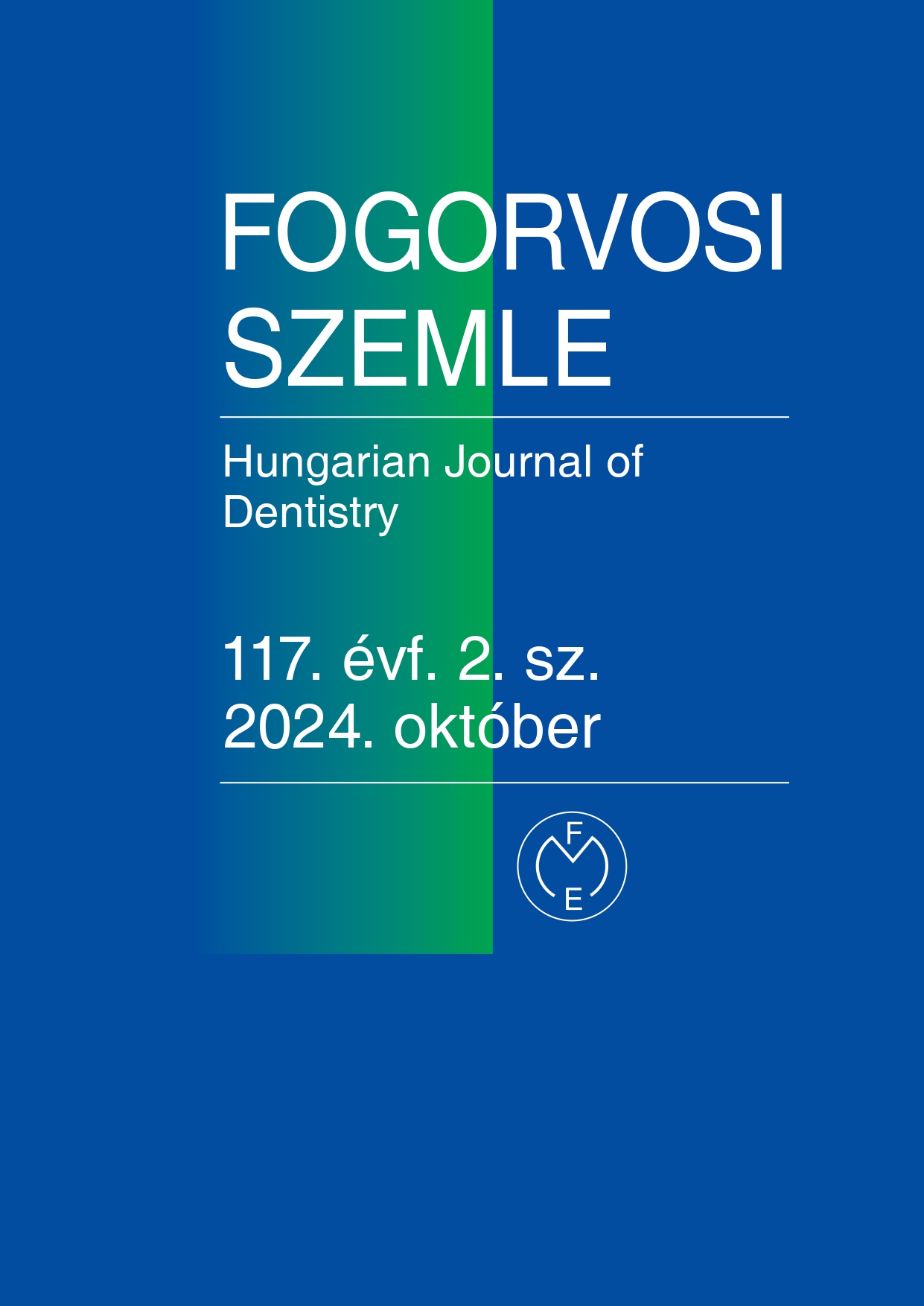Restoration of a molar tooth using hybrid ceramic overlay
Abstract
Thanks to developments in dental CAD/CAM technology, a variety of materials are now available for dental restorations, including different types of hybrid ceramics, also known as resin matrix ceramics. Hybrid ceramics are characterized by their inorganic ceramic content and varying proportions of organic polymer content. Additionally, the structure and composition of the ceramic grains differ across products. Hybrid ceramics are primarily utilized for individual restorations, such as crowns, veneers and inlays/onlays/overlays. This case study presents the use of Vita Enamic (Vita Zahnfabrik, Germany) hybrid ceramic overlay for restoring a lower root canal treated molar tooth. Overall, hybrid ceramics are considered suitable for the mechanical and aesthetic restoration of teeth.
References
Alves de Lucena M, Relvas A, Lefrançois M, Venício Azevedo M, Sotelo P, Sotelo L: Resin matrix ceramics – mechanical, aesthetic and biological properties. RGO – Rev Gaúcha Odontol 2021; (69): 1–7. https://doi.org/10.1590/1981-86372021001820190130
American Dental Association. CDT: Code on dental procedures and nomenclature. https://www.ada.org/publications/cdt (2024.03.27.)
Amesti-Garaizabal A, Agustín-Panadero R, Verdejo-Solá B, Fons-Font A, Fernández-Estevan L, Montiel-Company J, et al: Fracture resistance of partial indirect restorations made with CAD/CAM technology. A systematic review and meta-analysis. J Clin Med 2019; 8 (11). https://doi.org/10.3390/jcm8111932
Angeletaki F, Gkogkos A, Papazoglou E, Kloukos D: Direct versus indirect inlay/onlay composite restorations in posterior teeth. A systematic review and meta-analysis. J Dent 2016; (53): 12–21. https://doi.org/10.1016/j.jdent.2016.07.011
Aquilino SA, Caplan DJ: Relationship between crown placement and the survival of endodontically treated teeth. J Prosthet Dent 2002; 87 (3): 256–263. https://doi.org/10.1067/mpr.2002.122014
Bergman MA: The clinical performance of ceramic inlays: A review. Aust Dent J 1999; 44 (3): 157–168. https://doi.org/10.1111/j.1834-7819.1999.tb00217.x
Bustamante-Hernández N, Montiel-Company JM, Bellot-Arcís C, Mañes-Ferrer JF, Solá-Ruíz MF, Agustín-Panadero R, et al: Clinical behavior of ceramic, hybrid and composite onlays. A systematic review and meta-analysis. Int J Environ Res Public Health 2020; 17 (20): 1–23. https://doi.org/10.3390/ijerph17207582
Coşkun E, Aslan YU, Özkan YK: Evaluation of two different CAD-CAM inlay-onlays in a split-mouth study: 2-year clinical follow-up. J Esthet Restor Dent 2020; 32 (2): 244–250. https://doi.org/10.1111/jerd.12541
Duarte S, Sartori N, Phark JH: Ceramic-Reinforced Polymers: CAD/CAM Hybrid Restorative Materials. Curr Oral Heal Reports 2016; 3 (3): 198–202. https://doi.org/10.1007/s40496-016-0102-2
Fathy H, Hamama HH, El-Wassefy N, Mahmoud SH: Clinical performance of resin-matrix ceramic partial coverage restorations: a systematic review. Clin Oral Investig 2022; 26 (5): 3807–3822. https://doi.org/10.1007/s00784-022-04449-2
Fathy H, Hamama HH, El-Wassefy N, Mahmoud SH: Effect of different surface treatments on resin-matrix CAD/CAM ceramics bonding to dentin: in vitro study. BMC Oral Health 2022; 22 (1): 1–15. https://doi.org/10.1186/s12903-022-02674-5
Ferraris F: Posterior indirect adhesive restorations (PIAR): preparation designs and adhesthetics clinical protocol. I nt J Esthet Dent 2017; 12 (4): 482–502.
Fron Chabouis H, Smail Faugeron V, Attal JP: Clinical efficacy of composite versus ceramic inlays and onlays: A systematic review. Dent Mater 2013; 29 (12): 1209–1218. https://doi.org/10.1016/j.dental.2013.09.009
Goujat A, Abouelleil H, Colon P, Jeannin C, Pra delle N, Seux D, et al: Mechanical properties and internal fit of 4 CAD-CAM block materials. J Prosthet Dent 2018; 119 (3): 384–389. https://doi.org/10.1016/j.prosdent.2017.03.001
Gracis S, Thompson V, Ferencz J, Silva N, Bonfante E: A New Classification System for All-Ceramic and Ceramic like Restorative Materials. Int J Prosthodont 2016; 28 (3): 227–235. https://doi.org/10.11607/ijp.4244
He LH, Swa in M: A novel polymer infiltrated ceramic dental material. Dent Mater 2011; 27 (6): 527–534. https://doi.org/10.1016/j.dental.2011.02.002
Laborie M, Naveau A, Menard A: CAD-CAM resin-ceramic material wear: A systematic review. J Prosthet Dent 2022; 1–7. https://doi.org/10.1016/j.prosdent.2022.01.027
Magne P, So W Seup, Cascione D, Angeles L: Immediate dentin sealing supports delayed restoration placement. J Prosthet Dent 2007; 98 (3): 166–174. https://doi.org/10.1016/S0022-3913(07)60052-3
Manziuc M, Khec hen AA, Negucioiu M, Poiană I, Kui A, Mesaros A, et al: Survival Rates of Glass versus Hybrid Ceramics in Partial Prosthetic Restorations: A Scoping Review with Emphasis on Adhesive Protocols. J Clin Med 2023; 12 (21). https://doi.org/10.3390/jcm12216744
Milicich G: The compression dome concept: the restorative implications. Gen Dent 2017 Sep–Oct; 65 (5): 55–60.
Miyazaki T, Hotta Y, Kunii J, Kuriyama S, Tamaki Y: A review of dental CAD/CAM: current status and future perspectives from 20 years of experience. Dent Mater J 2009; 28 (1): 44–56. https://doi.org/10.4012/dmj.28.44
Paolone G, Mandurino M, De Palma F, Mazzitelli C, Scotti N, Breschi L, et al: Color Stability of Polymer-Based Composite CAD/CAM Blocks: A Systematic Review. Polymers (Basel) 2023; 15 (2): 1–17. https://doi.org/10.3390/polym15020464
Picolo MZD, Kury M, Romário-Silva D, Rosalen PL, Pecorari VGA, Gianinni M, et al: Effects of gastric acid and
mechanical toothbrushing in CAD-CAM restorative materials: Mechanical properties, surface topography, and biofilm adhesion. J Mech Behav Biomed Mater 2023; 138 (November 2022). https://doi.org/10.1016/j.jmbbm.2022.105606
Rega lo SC H, Santos CM, Vitti M, Rega lo CA, De Vasconcelos PB, Mestriner W, et al: Evaluation of molar and incisor bite force in indigenous compared with white population in Brazil. Arch Oral Biol 2008; 53 (3): 282–286. https://doi.org/10.1016/j.archoralbio.2007.10.003
Ruggiero MM, Soares Gomes R, Pedroso Bergamo ET, Freitas MIM, Bonfante EA, Del Bel Cury AA: Resin-matrix ceramics for occlusal veneers: Effect of thickness on reliability and stress distribution. Dent Mater 2021; 37 (3): e131–e139. https://doi.org/10.1016/j.dental.2020.11.002
Ruse ND, Sadoun MJ: Resin-composite blocks for dental CAD/CAM applications. J Dent Res 2014; 93 (12): 1232–1234. https://doi.org/10.1177/0022034514553976
Spitznagel FA, Scholz KJ, Strub JR, Vach K, Gierthmuehlen PC: Polymer-infiltrated ceramic CAD/CAM inlays and partial coverage restorations: 3-year results of a prospective clinical study over 5 years. Clin Oral Investig 2018; 22 (5): 197319–197383. https://doi.org/10.1007/s00784-017-2293-x
Tagte kin DA, Özyö ney G, Yanikoglu F: Two-year clinical evaluation of IPS Empress II ceramic onlays/inlays.
Oper Dent 2009; 34 (4): 369–367. https://doi.org/10.2341/08-97
Vita Enamic bonding protocol https://cdn.vivarep.com/contrib/vivarep/media/pdf/4_4643_ VITAENAMICBondingandPolishingGuide_20170830205802515.pdf (2024.03.27.)
Wahjuningrum DA, Norberto CRJ, Fernanda MML, Sari AA, Pawar AM, Cruz González AC: Micro-shear bond strength of different surface treatments on a polymer infiltrated ceramic network. F1000Research 2022; 11: 798. https://doi.org/10.12688/f1000research.122108.1
Yoshihara K, Naga oka N, Mar uo Y, Nishigawa G, Irie M, Yoshida Y, et al: Sandblasting may damage the surface of composite CAD-CAM blocks. Dent Mater 2017; 33 (3): e124–e135. https://doi.org/10.1016/j.dental.2016.12.003
Copyright (c) 2024 Authors

This work is licensed under a Creative Commons Attribution 4.0 International License.


.png)




1.png)



